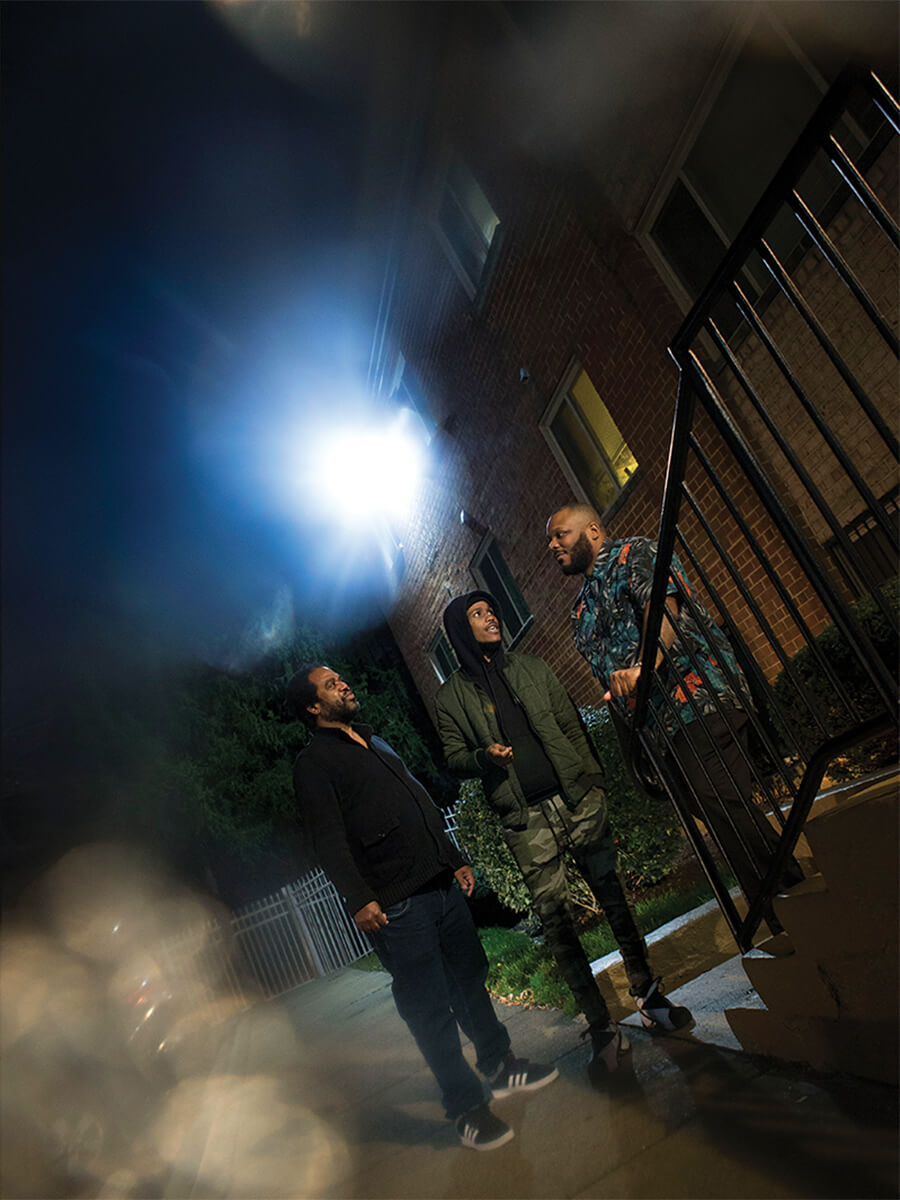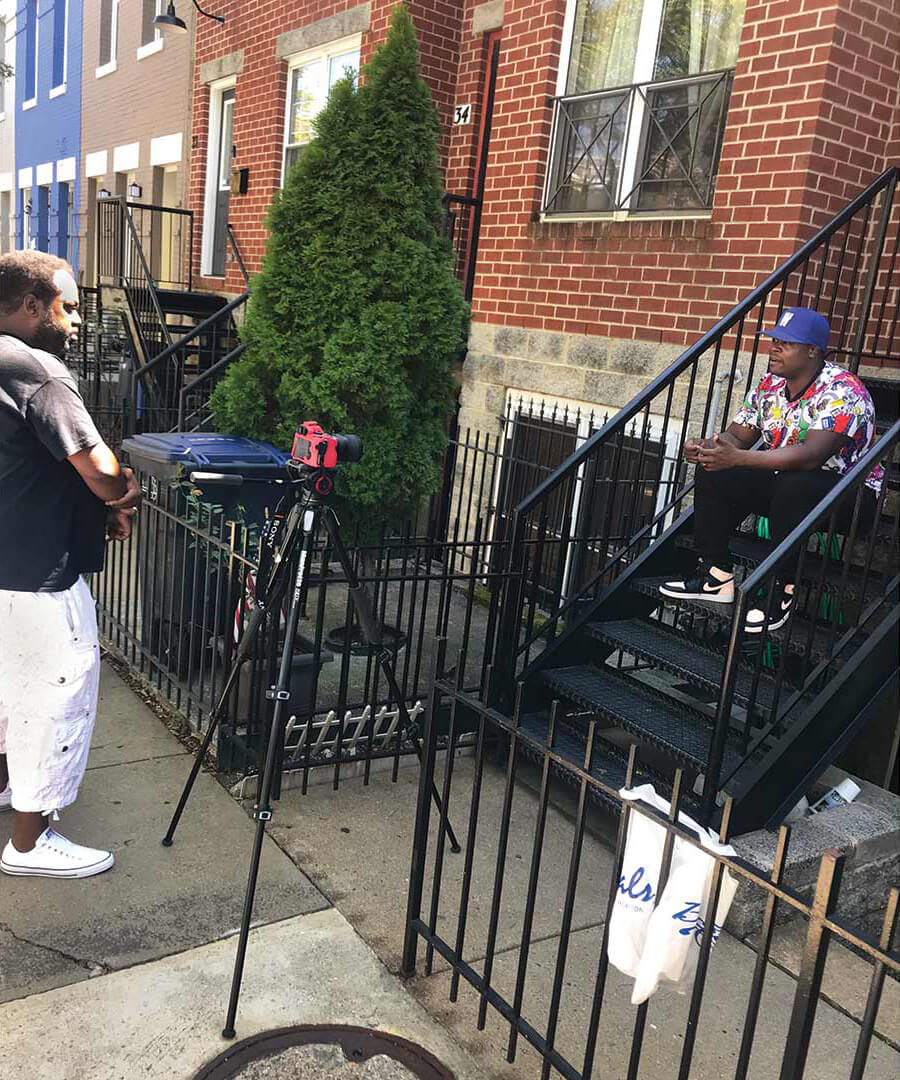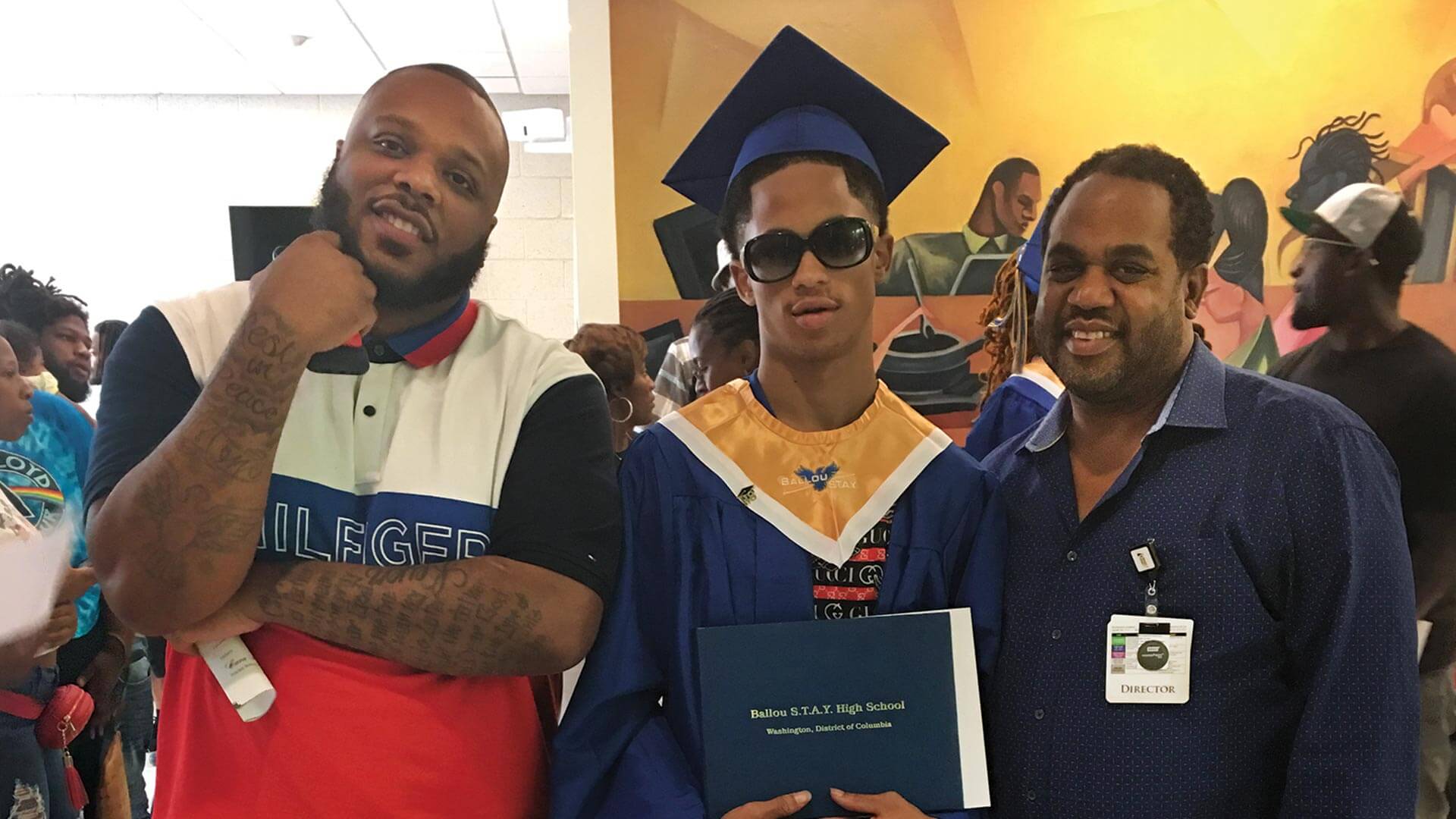- March 23, 2021
- By Liam Farrell
An August episode of the podcast “Life After the Gunshot” starts with two brash personas, but any artifice quickly fades.
“DocJoRich,” the host, shouts out to protesting NBA players, advocates for the arrest of the Louisville police officers who shot Breonna Taylor and asks listeners to support Black businesses. “Young Fre$h,” his guest, is an aspiring rapper from southeast D.C., calling in from the passenger seat of a moving car.
While the conversation starts casually, DocJoRich quickly steers it to spotlight a fundamental problem that Black men too often face.
 Young Fre$h is also Chris Edge, who survived a dozen stab wounds only to be shot while on the streets in January 2019. He wasn’t out that night partying; he was trying to sell his food stamps benefits card to cover basic expenses while his partner was working unpaid for the Transportation Security Administration during a federal government shutdown. In other words, he put himself in danger in order to stave off the threat of eviction.
Young Fre$h is also Chris Edge, who survived a dozen stab wounds only to be shot while on the streets in January 2019. He wasn’t out that night partying; he was trying to sell his food stamps benefits card to cover basic expenses while his partner was working unpaid for the Transportation Security Administration during a federal government shutdown. In other words, he put himself in danger in order to stave off the threat of eviction.
The host who coaxes this story out of him is also known as Joseph Richardson Jr., the Joel and Kim Feller Endowed Professor of African American Studies and Anthropology at the University of Maryland. Richardson virtually gives Edge the mic to respond to anyone who would stereotype him as bearing the responsibility for getting shot even though, in the context of his life, he’d made a rational decision.
“You cannot, I repeat, cannot just automatically say, ‘Hey, this guy’s a bad guy,’” says Edge, who shares his story to encourage Black men to seek mental health treatment and will be a teaching assistant this semester in Richardson’s class on structural and interpersonal violence. “I was just walking down the street.”
Brave, empathetic and groundbreaking, Richardson is broadcasting the kind of research he’s been conducting for decades on the causes and consequences of urban bloodshed for young Black men. He’s also an interventionist, running programs based out of hospital trauma centers to get victims of violence the psychosocial services they need to survive.
It’s a mission that thrives amid the tension of the quantitative and the qualitative, the lab and the field. Collecting numbers is helpful, but just as important to Richardson is hanging out in hospital hallways and finding out whether any doctors and nurses are disparaging their wounded Black patients as getting comeuppance for bad choices.
“We can get by these assumptions and get down to the humanity of the people who are there,” he says. “It’s not just about patching people up and going home. Have they ever been to those neighborhoods? Like, really been to those neighborhoods, not just driven through?”
As the ongoing coronavirus and urban policing crises reveal and deepen stress in the African American community, Richardson is branching out with his podcast, a documentary miniseries and a new research project on how Black men understand and cope with institutional racism and trauma, a struggle he knows as much as his subjects.
“This is just part of being Black in America,” he says, “and being in this skin.”
DocJoRich grew up as JoJo in the northwest Philadelphia neighborhoods of East Mount Airy and East Germantown as they transitioned in the 1970s from predominantly Jewish to lower middle-class African American families. Richardson’s father, a well-known jazz vocalist who bequeathed both his name and nickname to his son, worked in a Sears warehouse, and his mother was a public schoolteacher who used to take him to her night classes at Temple.
 Michael Bailey, a childhood friend, says Richardson was lighthearted and easygoing yet had a serious, academic side. They were surrounded in youth football and soccer and on the streets by strong Black male role models who showed them the value of taking care of their own neighborhoods.
Michael Bailey, a childhood friend, says Richardson was lighthearted and easygoing yet had a serious, academic side. They were surrounded in youth football and soccer and on the streets by strong Black male role models who showed them the value of taking care of their own neighborhoods.
“Men were active, men were visible,” Bailey says. “You treated (a neighbor’s) house like your own house.”
That sense of responsibility was critical when the crack epidemic of the 1980s started to make inroads in the area, says Hubie White, a lifelong friend who Richardson considers an older brother.
“That neighborhood is still beautiful because of the parents and the community,” he says. “Everybody stood tall. We prevailed.”
White says that Richardson frequently lived up to the example set by older residents by acting as a peacemaker among his peers when fights or arguments broke out in the streets or playgrounds.
“He’s the perfect person for the betterment of his community,” he says.
Graduating from one of Philadelphia’s best schools, George Washington Carver High School of Engineering and Science, and then the University of Virginia, Richardson originally thought of becoming a Secret Service agent or FBI profiler like the heroine in “The Silence of the Lambs,” and bounced between internships and research projects in the early 1990s while pursuing a master’s degree in criminology and criminal justice. He eventually landed as an ethnographer for a project on youth violence while studying at Rutgers University.
It was Richardson’s true introduction to field work, as he recruited 25 middle school kids from central Harlem to study how they navigated the challenges of a neighborhood dominated by the Bloods and Crips. It was also a vivid reminder of how a burgeoning academic profile wouldn’t shield him from aggressive policing, like the time a police officer pulled him over in New York City, erroneously told him his license plates were stolen and, before letting Richardson go, remarked that he would have shot him if he had made any sudden moves.
From there, his projects continued to probe at the intersection of the individual and the institutional, examining prison re-entry programs in New York and Chicago and the employment challenges facing high school dropouts in Philadelphia. After Richardson came to UMD as an assistant professor in African American studies in 2006, he began a study on youth offenders held in adult jails in Washington, D.C.
The research served as a turning point, for while it was an interesting case study, it also made Richardson feel depressed and powerless. Held in federal custody, the teenagers could be transferred at a moment’s notice hundreds of miles away; Richardson recalls once meeting with a young inmate whose 4 a.m. flight had been grounded by mechanical problems.
“They were taking me to South Dakota,” the boy told Richardson. “Where is that?”
Richardson craved digging further, down to the problems that propel people into the criminal justice system in the first place, and help find them a way out. He discovered a potential path when he saw a CNN story on Dr. Carnell Cooper, then a Baltimore trauma surgeon who had created a program to connect victims of violence with psychosocial services like substance abuse counseling and job training.
“I wanted to replicate what he did,” Richardson says.
The first time Che Bullock met Richardson in 2013, he was wearing a bulletproof vest and carrying a .40-caliber handgun.
At the time, that was Bullock’s standard routine. Active in drug dealing, the southeast D.C. native had been stabbed 13 times during a nightclub fight and flown by helicopter to the hospital. When Richardson’s project partner, postdoctoral researcher Chris St. Vil, called afterward to ask if Bullock would be part of a new project, he understandably hesitated.
 “I didn’t know if he was police, or an enemy trying to set me up,” Bullock says.
“I didn’t know if he was police, or an enemy trying to set me up,” Bullock says.
Other potential recruits were just as skeptical when Richardson and St. Vil, now an assistant professor at the University of Buffalo School of Social Work, first approached them in the hospital for a study on risk factors for recurring violent injuries among Black men. Identifying what contributed to that repetition—about 32% for patients at that hospital and as high as 60% in certain parts of the country, Richardson says—was the first step in building a new intervention program.
Prince George’s Hospital Center turned into Richardson’s lab after he cold-called and struck up a working relationship with Cooper, who became the institution’s chief medical officer. Richardson speculated that the medical field might be the nexus point to address the individual and systemic strands that lead to gun violence.
But first they needed people to talk to, and the pair got nowhere when they wore blazers and ties to patients’ hospital rooms. One man even called Richardson’s office number off his business card when they were together, just to confirm he was really a professor.
“Guys thought we were the cops,” Richardson says. “Why would a university professor come in the room? That was totally unrealistic to them.”
That suspicion waned when they dropped the formalities (“It’s pretty easy for me to be my natural, Philly self,” Richardson says), and Bullock was won over by Richardson’s willingness just to listen and not judge him. A short time later, he even spoke to one of Richardson’s classes at UMD, although Bullock’s own story almost ended that night when his car was sprayed by bullets on the way home.
The professor told him afterward it was time for a change, and offered him a new start as an intermediary, or “credible messenger” to reach out to the patients recruited for Richardson’s Capital Region Violence Intervention Program, which launched in 2017. Over the next two years, Bullock found new purpose working alongside Richardson—“he saved my life”—and helping 116 Black men connect with services ranging from housing assistance and legal aid to mental health counseling; only one came back with a violent injury.
For many participants, Bullock says, the mental health therapy was the most important piece.
“A lot of these guys are born into trauma, walking home and seeing the eviction notice on their door or their father killed in front of them,” he says. “We are what we see. It’s just the truth.”
It was also an eye-opening experience for St. Vil, who leaned on Richardson to develop his own research techniques. Not only was the project a demonstration that young Black men can be engaged in academic studies, he says, but it also affirmed the opportunity for a “golden moment” where the course of someone’s life can be changed.
“They probably never would have come into contact with a service agency without the hospital,” St. Vil says. “The main goal is, do we get them to a point of self-sufficiency where they can be a better manager of their life?”
As a Black man with a strong command of urban culture, from the latest music news to a longtime boxing fandom, Richardson is positioned better than lots of academics to cross over from a university into a community like southeast D.C. and come away with information. The young men he works with affectionately address him as “Doc,” providing the first part of his podcast moniker.
But that basic identity only goes so far in neighborhoods where all outsiders are treated with suspicion, and Anacostia differs from Harlem in its particulars just like Harlem differs from northwest Philadelphia.
“You don’t necessarily get a pass into that space,” Richardson says. “Some things you understand, but a lot of things you don’t.”
That philosophy gives Richardson the strength and ability to search for answers in places that most scholars avoid, says Ruth Enid Zambrana, a distinguished university professor in UMD’s Harriet Tubman Department of Women, Gender, and Sexuality Studies and a mentor of Richardson. He unearths not just the weaknesses in poor Black neighborhoods, but also the strengths—like his research on the importance of uncles for inner-city Black youth—and “has really broken the boundaries of the field,” she says.
“He is treading water that no one else has dared to go in,” Zambrana says.
Richardson has gone full circle now, and continues violence intervention efforts at the same Baltimore program started by Cooper at the R Adams Cowley Shock Trauma Center. Two related projects are in the pipeline as well, including a four-part documentary series based on interviews with 10 trauma victims he met through his work in Prince George’s County. He envisions it forming the basis of a show similar to HBO’s iconic “The Wire,” blending the stories of individuals with the criminal justice, neighborhood and medical situations that shape their lives.
The other is a joint effort with two colleagues from the UMD School of Public Health, Associate Professors Craig Fryer and Kevin Roy, with support from the university’s Brain and Behavior Initiative. By recruiting and interviewing Black men from local barbershops, the UMD Center for Healthy Families and the Prince George’s trauma unit, the team will study how the subjects understand their own traumatic experiences, the health impacts of race-related stress, and strategies for building resilience.
“Joe really brings this strong background in sociology and criminal justice … (and) how to think about systems and how they interact with the lives of Black men,” Fryer says. “They are quite diverse, and there is no such thing as ‘the Black male.’ There’s much more richness to who they are.”
The work remains urgent as COVID-19 and its attendant economic fallout continues to wreak disproportionate havoc on minority populations, with the homicide rate spiking in cities including Washington, D.C. (“People going crazy ’cause they been in the house,” Edge told Richardson on his podcast. “Since March, my city been turned up to a whole ’nother level.”)
Richardson, however, needs no reminders of the wages of gun violence, either personally or professionally. Just two years ago, his best friend, a married father and attorney, killed himself with a gun; and in November 2019, one of his documentary subjects, Majhe Powers, was murdered.
A primary caregiver for his siblings and recent graduate of the Run Hope Work vocational training program, Powers, 21, had also been accepted to community college when police found him with gunshot wounds in the hallway of a southeast D.C. house. When he saw the body of someone he tried to save in a casket, Richardson says, he couldn’t help but also feel accountable—just as he feels accountable for the violence meted out daily in communities struggling with poverty, drugs, guns and the institutional disconnect that too often leaves helping hands out of reach.
“As a Black male professor, you can’t really separate yourself,” he says. “The work that we do is very life-and-death.”
